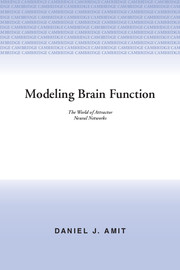Book contents
- Frontmatter
- Contents
- Preface
- Dedication
- 1 Introduction
- 2 The Basic Attractor Neural Network
- 3 General Ideas Concerning Dynamics
- 4 Symmetric Neural Networks at Low Memory Loading
- 5 Storage and Retrieval of Temporal Sequences
- 6 Storage Capacity of ANN's
- 7 Robustness - Getting Closer to Biology
- 8 Memory Data Structures
- 9 Learning
- 10 Hardware Implementations of Neural Networks
- Glossary
- Index
2 - The Basic Attractor Neural Network
Published online by Cambridge University Press: 05 August 2012
- Frontmatter
- Contents
- Preface
- Dedication
- 1 Introduction
- 2 The Basic Attractor Neural Network
- 3 General Ideas Concerning Dynamics
- 4 Symmetric Neural Networks at Low Memory Loading
- 5 Storage and Retrieval of Temporal Sequences
- 6 Storage Capacity of ANN's
- 7 Robustness - Getting Closer to Biology
- 8 Memory Data Structures
- 9 Learning
- 10 Hardware Implementations of Neural Networks
- Glossary
- Index
Summary
Networks of Analog, Discrete, Noisy Neurons
Analog neurons, spike rates, two-state neural models
The two-state representation of neural output, which enjoys such a wide popularity among modelers of neural networks, is often considered oversimplified both by biologists and device designers. Biologists prefer to describe relevant neural activity by firing rates. These are continuous variables describing mean spike activity of neurons, rather than the discrete variables which describe the presence or the absence of an individual spike. Device designers prefer sometimes to think in terms of operational amplifiers, currents, capacitances, resistors, and continuous time equations. It turns out that in a wide range of parameters the performance of a network as an ANN is largely independent of the representation[1]. As we shall see in the following chapters, e.g., Chapter 5, the discrete representation provides a more transparent framework for structured manipulations of attractors.
Eventually the gap between the different descriptions, closes, because in our formulation of the output mechanism, Section 1.4.4, a significant event is said to occur when a time average over spike activity is found to be high, which is nothing but a measure of mean firing rates. On the other hand, in the analog description, in terms of electronic components, which is deterministic in structure, one eventually generates spikes, stochastically, at a mean instantaneous rate proportional to the continuous variable at hand, e.g., the potential excess over the threshold.
- Type
- Chapter
- Information
- Modeling Brain FunctionThe World of Attractor Neural Networks, pp. 58 - 96Publisher: Cambridge University PressPrint publication year: 1989
- 5
- Cited by



